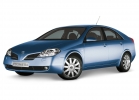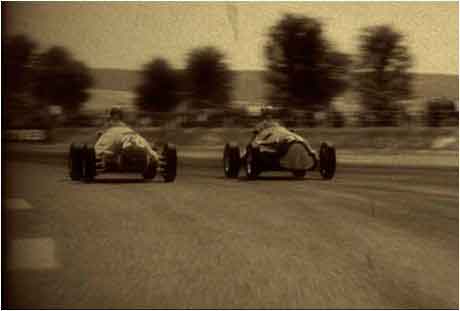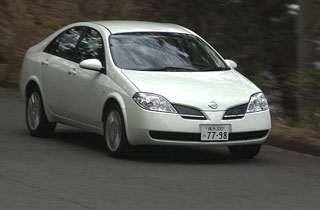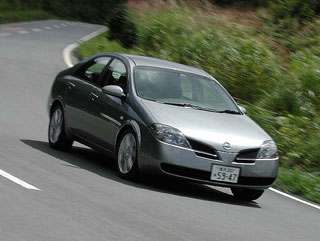Test drive Nissan Primera sedan since 2002 sedan
TV on wheels
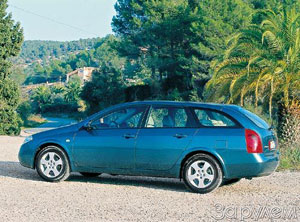 The Nissan Primer shows, tells and ... drives!
The Nissan Primer shows, tells and ... drives! When they say: the indestructible, like a Japanese TV, is certainly about Nissan. There is a button, there is a ignition lock, but the result is one: I supplied power - and go without problems for 5, 10, 15 years. And if seriously, then the reputation of practical, durable, very reliable and at the same time relatively cheap car in Russia is difficult to earn. Passenger Nissans, regardless of the model, year of release, belonging to the Japanese or European market, have such a set of qualities. Nevertheless, the portrait of an almost perfect foreign car will be incomplete without one significant reservation: the Nissans lack expressive appearance.
We buy tomorrow, go today
The Nissanists were in such a hurry to show the novelty of the press that the cycle of trial trips took place on the pre -production machines assembled with the use of bypass technologies, for which data on the equipped mass, maximum speed, acceleration to a hundred, etc. have not yet been approved.
The rush is understandable: competition in the middle class (European segment D) is so strong that revolutionary changes in appearance, and even more so the change of concept should be demonstrated as quickly as possible. And Nissan’s designers actually surprised: complex body forms, an unusual combination of corners and rounding - in a word, an original corporate identity and one hundred percent recognition.
And what's inside?
Fedot, not the same
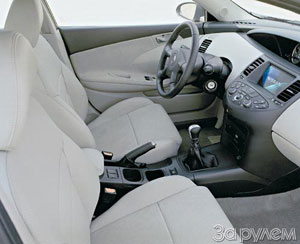 From the elements of the interior typical of Japanese firms, only steering wheel switches remained with characteristic durles to control headlights and wipers. The rest is Europe. Skin -haired sports steering wheel with a small hub (they still managed to squeeze the airbag) - Italian motifs. Convenient front seats with developed side supports and an abundance of servo drives will appreciate fans of German cars. A combination of devices located in the center of the torpedo - from the French menu. And round dials of a tachometer and a speedometer with aluminum edging and nothing more than a European standard for cars with character. All these details, in perfect harmony with each other, only framed the main novelty - the on -board information terminal. Simply put, a kind of multifunctional TV. Its color liquid crystalline display is located vertically, while the block of control buttons, toggle switches and joysticks (!) A horizontal platform is highlighted - a ledge on the central console.
From the elements of the interior typical of Japanese firms, only steering wheel switches remained with characteristic durles to control headlights and wipers. The rest is Europe. Skin -haired sports steering wheel with a small hub (they still managed to squeeze the airbag) - Italian motifs. Convenient front seats with developed side supports and an abundance of servo drives will appreciate fans of German cars. A combination of devices located in the center of the torpedo - from the French menu. And round dials of a tachometer and a speedometer with aluminum edging and nothing more than a European standard for cars with character. All these details, in perfect harmony with each other, only framed the main novelty - the on -board information terminal. Simply put, a kind of multifunctional TV. Its color liquid crystalline display is located vertically, while the block of control buttons, toggle switches and joysticks (!) A horizontal platform is highlighted - a ledge on the central console. Japanese firms can do electronics, so there is no doubt about its reliability and durability. If you have already implanted the monitor into the car, the picture will be clear and you will look at it almost more often than on the road. The Nissan terminal heads the work of the audio system, climatic installation, built -in on -board diagnostics, route computer and integrated mobile phone. It also signals the open door or trunk lid, unlucky energy consumers and. e. If you used the navigation system, the TV will show the three -dimensional (!) image of the road and will be informed with a pleasant female voice when and where to turn. Turned on the rear passage - forget about the mirrors. It is better to look at the screen - there the black and white picture from the built -in television camera shows the space behind the rear bumper. No blind areas, park with an accuracy of centimeters - I checked it yourself.
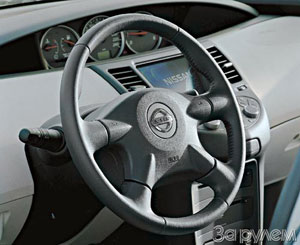
A noticeable drawback of the terminal is too bright. When you turn on the near light of headlights, it fades slightly, but at night or, say, in the tunnel the glow of the monitor still distracts from the road. Well, the driver, far from innovative technologies, is likely to be overloaded with information and is unlikely to want to delve into all the talents of the terminal. I'm afraid it will be confused in the buttons even when trying to configure the audio system.
If we were talking about electronics, I note that the rain sensor for C
teklo -cleaners, ABS, system distribution systems and dynamic stabilization in a new example, of course, are present. On the snack - intellectual cruise control. If it is turned on, laser sensors measure the distance to the in front of the running machine, the brain analyzes this data and, if necessary, slows down the engine, or even the brake system, to maintain a safe distance.
The listed newfangled devices in one form or another are found on cars in a class higher and their price is larger, but Nissan combined them in one model and made them
venerable. It will cost it noticeably cheaper than a Mercedes, Audi or BMW.
Gasi screen, crush for gas
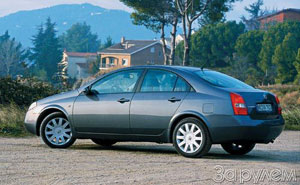 It's time to distract from electronic miracles for the sake of actual prose - running qualities and reliability. Did Nissan save the best family features? The pre -production sample is not the most suitable object for evaluation, and yet, without any discounts, we will answer the question in the affirmative. The company is still not chasing spectacular engine power numbers. This is commendable - it means that the durability did not become a victim of forcing. A gasoline 16-valve with a volume of 1.8 liters develops only 85 kW. Nevertheless, a sedan with such an engine and a mechanical five -speed gearbox is a completely live car.
It's time to distract from electronic miracles for the sake of actual prose - running qualities and reliability. Did Nissan save the best family features? The pre -production sample is not the most suitable object for evaluation, and yet, without any discounts, we will answer the question in the affirmative. The company is still not chasing spectacular engine power numbers. This is commendable - it means that the durability did not become a victim of forcing. A gasoline 16-valve with a volume of 1.8 liters develops only 85 kW. Nevertheless, a sedan with such an engine and a mechanical five -speed gearbox is a completely live car. The motor confidently disperses the car, allows you to nimble in the city crowd and rush along the autobahn under 200 km/h, confidently storm the protracted climbs. There are no complaints and to the brakes. New multi -link pendants are very good on the asphalt - they hold the car perfectly both in a steep turn and in the canopy
virage - frightening rolls are absent. At the same time, comfort was not affected - the smoothness of the car corresponds to the car class. But the most impetuous thing is that on the lane an example is by no means helpless. The toothbrushing shaking, the ominous clatter of the chassis, there is simply no swing from the nose to the stern, the car does not stir with a belly on small tubercles - the road clearance was actually acceptable.
It is a pity that not only dignity is inherited. The gasoline engine of the new Nissan is as noisy as the predecessors. The fifth gear is turned on, only 3500 rpm on the tachometer, and the motor is already drowning out all other sound sources. In fairness I note - in this hollow you feel even a certain charm, and it is not very annoying.
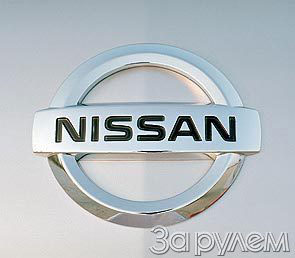
But here is a change of car, and with it a riddle: a station wagon equipped with a turbodiesel with direct injection, in comparison with a sedan quiet, like a mouse. Although the engine with a difficult genealogy is installed here - the same Nissan X -Trail all -resistant. Turgodiesel, combined with a six -speed box, has its own characteristics. On the plain, the most popular gears are IV, V and VI. The lower short ones, you are sorting out, like a tongue twister - to get to the highest faster, and then you enjoy the traction capabilities of the turbodiesel. In the mountains, on steep lifts, you find that the second turn is too high, while on the third he pulls sluggishly. Here you remember a less powerful noisy gasoline 1.8 - under these conditions, it is preferable to a diesel counterpart.
In conclusion, several comments common to both machines. The adhesion pedal move is too large, the touch point is highly located, the steering amplifier is soft - the feeling of the car is lost, but the gas pedal is very tight - the leg is quickly tired. He also noted other flaws - mostly ergonomic. The company has time to finish the samples. Our motorists are not idle interest in Nissan: they will buy a new example. It doesn’t matter that its design has become more complicated, if only the car remains easy to use, comfortable and reliable. Like a Japanese TV.
The Nissan-Primer concept carrier debuted at the 2000 Paris Motor Show, and the third-generation serial example created on its basis was presented in the fall of 2001 in Frankfurt. In Europe, the sedan and the station wagon will begin to be sold in March, five -door hatchbacks in June -July. Cars will be equipped with 1.6 gasoline engines; 1.8; 2.0 l (80, 85, 103 kW) or a 2.2-liter turbodiesel with a capacity of 93 kW. The gearboxes are mechanical five- or six-speed, automatic four-speed or wedge-relaxed CVT-M6, which maintains manual control mode.
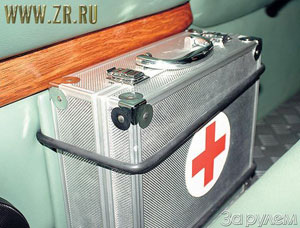
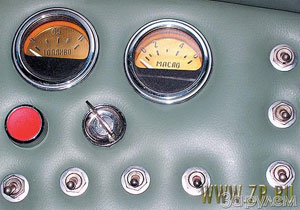
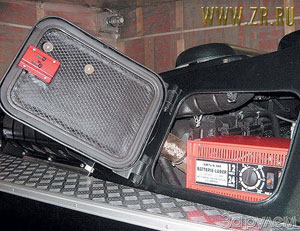
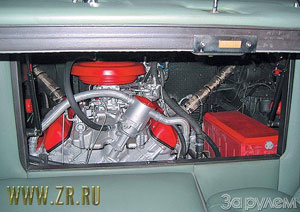

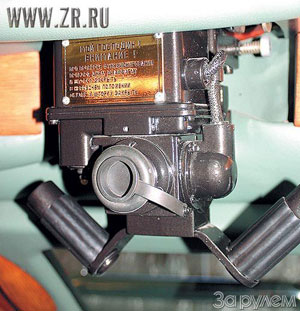
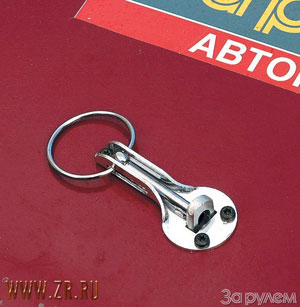
Vadim Kryuchkov
Photo Vadim Kryuchkov and Nissan company
Source: The magazine "Driving"
Video Crash tests Nissan Primera sedan since 2002
Nissan Primera Sedan tests since 2002
Nissan Primera Crash Test sedan since 2002
Krassh Test: Detailed Information29%
Driver and passengers
9%
Pedestrians
Nissan Primera malfunctions since 2002
Nissan Primera Sedan malfunctions: Detailed information| Primera sedan since 2002 | |
|---|---|
| Engine |  |
| Transmission |  |
| Control system and suspension |  |
| Brake system |  |
| Air heating and air conditioning |  |
| Launch and charging system |  |
| Electric components and so on |  |
| Corrosion body stability |  |


